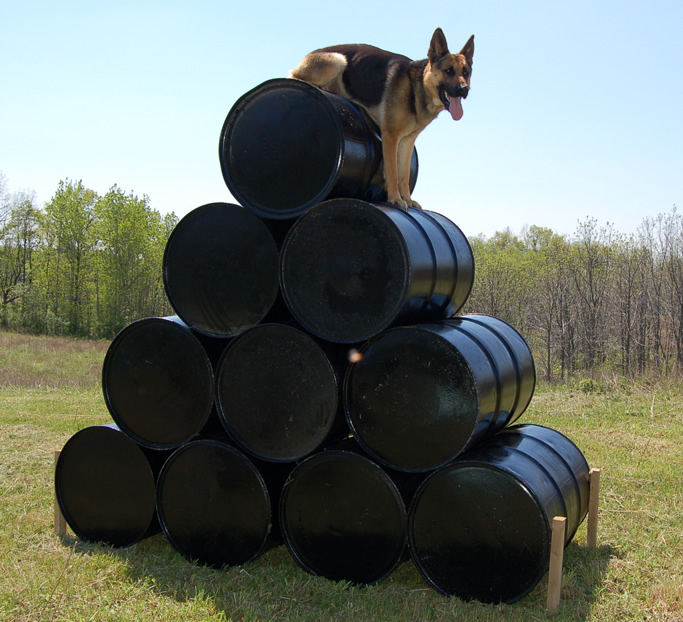The work of protection dog is a unique one that utilizes the ancient bond between mankind and canine developed over centuries. The specific Protection Dog Training that we do is unlike mainstream training and encompasses many different aspects, including obedience, agility, article search, man-scent tracking, and bite work/protection. This is what we here at CCPD call “functional protection dog training.”
Without the bribery of food, balls or tugs for rewarding the dog, we are able to motivate the dogs to work for the handler instead of a reward. This is done through effective communication. Instead, we reward the dog with “verbal cookies”, such as “good sit” when they fulfill a “sit” command. However, communication with the dog goes beyond just positive reinforcement – it also includes interaction with the dog. Maintaining a calm and assertive disposition, how the lead is being held, the tonality of the handler and overall body language are all things that are taken into consideration when communicating effectively with your protection dog – especially while training.

The foundation of the work is rooted in obedience. Unlike biting or scent work, obedience is unnatural to a canine. As early as five weeks old, we introduce our puppies to the collar and leash. During the first stages of obedience training the dog is exposed to different types of surfaces and elevations while incorporating commands such as, “sit”, “stay”, and “down”. The unfamiliar surface and the height of the elevation distracts the dog and will relieve the stress of the obedience training.
The agility course that we incorporate into our training is non-conventional and is constructed with different types of materials including corrugated metal, wooden planks, ladders, skids, barrels, tires and other commonly found objects. Agility work starts at five weeks hand-in-hand with the introduction to obedience. We begin by familiarizing the dog with the different types of surfaces and elevations. When the dogs begin to develop confidence with the change in environment, they are ready to learn rear foot replacement. Unlike cats, dogs are not born with this skill and will have to be taught. This is done by making the dog aware of their hind feet by assisting them across the agility course and physically moving their rear feet into place as they progress through.
In traditional sport such as KNPV (Royal Dutch Police Dog Association), the dog is sent out to search for small objects such as a ring, key or 9mm casing and retrieve it for the handler. The dog has ten minutes to locate and bring back all of the items with a perfect score being under three minutes. However, this method contaminates the objects and may result in compromising the condition of the item. In a practical situation, whether it be court evidence, a cell phone or a ring, these outcomes are best avoided. Instead, by using the dogs’ natural ability to indicate on scents, it is best to train the dog to sit or down near the location of the item. Using this method will prevent the contamination and damage of important items.
The dog has a brilliant sense of smell and can discriminate between multiple scents on one object. At six weeks, we begin to reinforce man-scent by hiding the handler a short distance from the dog. When given the seek command, the dog is deployed. Upon locating the handler, the dog is praised with good seek. This is repeated once again, except this time the handler hides in a different location near the previous one. When the dog returns to the familiar hiding spot, it will have to track the handlers’ scent to find his/her new location. The dog is then praised for following the correct scent. When the dog grows out of the learning phase, a seven foot lead is incorporated or a thirty foot lead for a longer track.
A real dog bite in a live situation will be with the dog’s canine teeth. Today, the practice of teaching the dog to use its molars to bite is against their natural instinct and is counterproductive. Unfortunately, there is a misconception that a dog uses its canines to bite only out of fear. When a wolf hunts and kills a deer with its canines, it is not doing this out of fear, but for survival. The same is true of a real protection dog to a real threat.
Protection is not a game. It is about ensuring your safety. In the sporting world of protection, there are a few exercises that are either pointless in a practical application or simply harmful to the dog. For example, teaching your dog to bark and hold in a real life situation can get them shot or stabbed. In fact, one exercise includes the dog taking a bite following a decoy repeatedly hitting the dog with a stick. The dog is expected to hold the bite while under this stress to prove fearlessness of the stick. If this were a real situation, the dog could easily be killed by an assailant because of poor training.